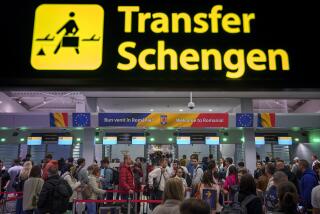Rail Passes for Eastern Europe
- Share via
Many travel magazines and newspaper travel sections were emphasizing Central European cities in 1990--before Iraq’s invasion of Kuwait and the ensuing Persian Gulf War put a damper on transatlantic travel.
The numerous great museum collections, palaces and ancient ruins of Central Europe had not been visited in force by Americans since the 1930s. With the default of Communism there, the gates to that area swung open again for the first time in more than 50 years. Moreover, hotel and restaurant prices there last year, as they still are, were far lower than in Western Europe.
Now that Americans are resuming foreign travel, the lure to visit Bulgaria, Czechoslovakia, Hungary, Poland, Romania and Yugoslavia has been renewed.
Train travel in those countries is less stressful than driving a a car and considerably less expensive than flying. And all of the cities in that area that interest Americans are linked by train service. Vienna is a gateway for rail travel to Prague, Berlin, Warsaw, Budapest, Belgrade, Bucharest and Sofia.
The unification of the two Germanys has improved and simplified the Warsaw-Berlin train service (nine hours, $53 for a first-class ticket), as well as the Vienna-Prague-Berlin trip (14 hours, $97).
An ideal train itinerary for Central Europe starts in Berlin. First, go Berlin to Prague (six hours, $30), then either Belgrade-Sofia (eight hours, $29) or Belgrade-Athens (20 hours, $76 plus $60 for one of the two berths in a sleeping compartment for two persons).
The Czechoslovakian portion of the Berlin-Prague route, all of the Vienna-Budapest ride and the Hungarian portion of the Budapest-Belgrade ride are covered by the European East Pass described below.
The level of Hungary’s train service qualified it in 1989 to become the 17th country that honors the Eurailpass.
The other 16 are Austria, Belgium, Denmark, Finland, France, Germany, Greece, the Netherlands, Republic of Ireland, Italy, Luxembourg, Norway, Portugal, Spain, Sweden and Switzerland.
The Hungarian Rail Pass was introduced last year. It is sold by both travel agencies and Hungarian Railways Inc. (2505 Braemore Road, Columbia, Mo. 65203-1374, 314-445-3460).
Its adult first-class prices for consecutive days are: 10 days, $109; 20 days, $159; 30 days, $209. For second-class: $69, $109 and $139. Half-fare for children 5 to 10. Children under 5 travel free.
This year, Hungarian Railways added a first-class-only Flexipass, sold by travel agencies and Rail Europe (226 Westchester Ave., White Plains, N.Y. 10604). Its adult prices are: any 5 in 15 days, $35, and any 10 days in a month, $55.
Also this year, Hungary combined with Austria, Czechoslovakia and Poland to participate in the new European East Pass, sold by travel agencies and Rail Europe. Its current adult prices: any 5 in 15 days, $160, and any 10 days in a month, $259.
Each of those three passes is good for unlimited train travel on the days covered. Both the Hungarian Flexipass and European East Pass charge half-fare prices for children 4 to 11. Children under 4 travel free.
Budapest is connected by rail with Athens, Belgrade, Brussels, Cologne, Copenhagen, Frankfurt, Hamburg, Leningrad, London, Moscow, Munich, Paris, Prague, Rome, Sofia, Stockholm, Venice, Vienna, Warsaw and Zurich.
Poland’s Polrailpass is sold by the Polish Travel Bureau (Orbis) at 342 Madison Ave., New York 10173, and at Orbis offices in Poland. The current first-class prices are: 8 days, $50; 15 days, $60; 21 days, $67; one month, $75. For second-class: $35, $40, $45 and $50. Half-fare for children, but sources at the Orbis New York office could not provide the age definition for “children.”
Note that many European cities have more than one rail station. For example, Budapest has three: Deli, Keleti and Nyugati. The train on which you are going to continue a trip may depart from a different station than the one at which you arrived. This applies also to Belgrade, Berlin, Bucharest, Prague, Vienna and Warsaw.
More to Read
Sign up for The Wild
We’ll help you find the best places to hike, bike and run, as well as the perfect silent spots for meditation and yoga.
You may occasionally receive promotional content from the Los Angeles Times.






